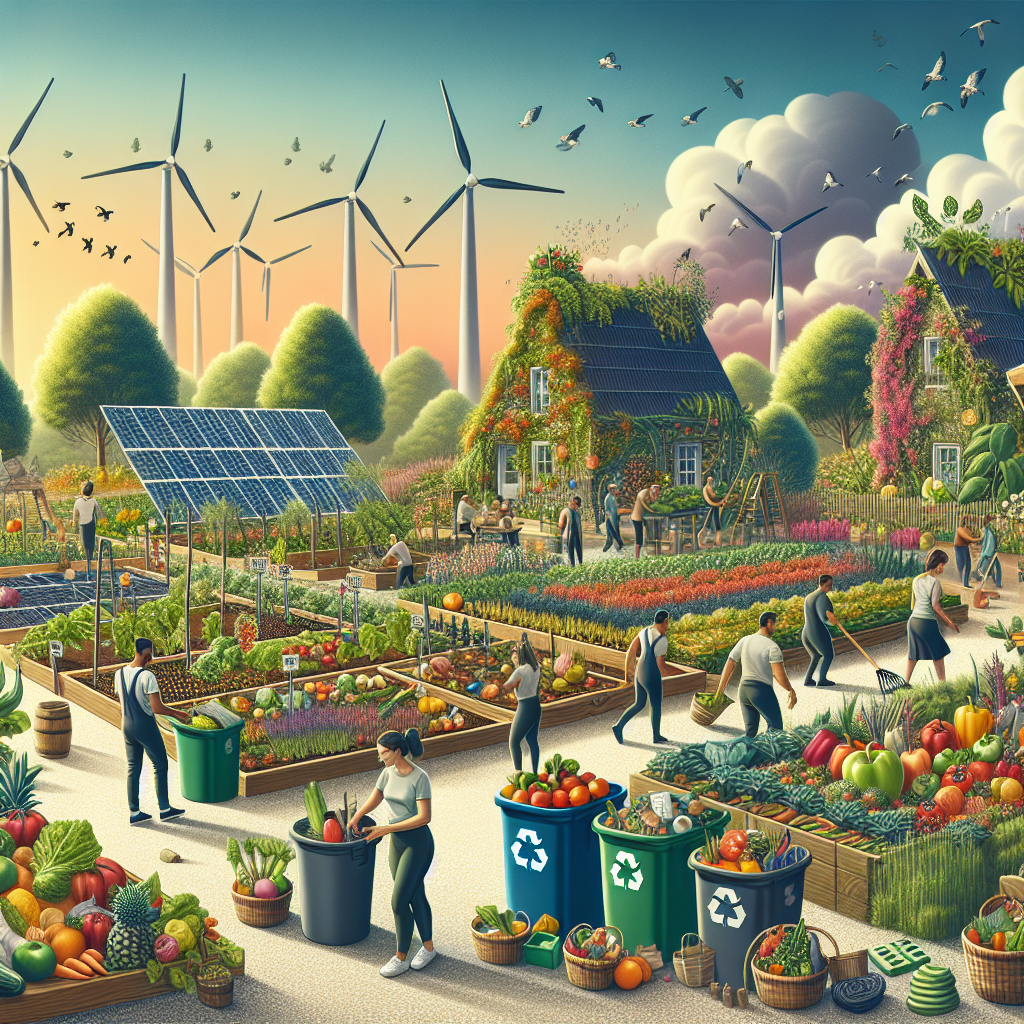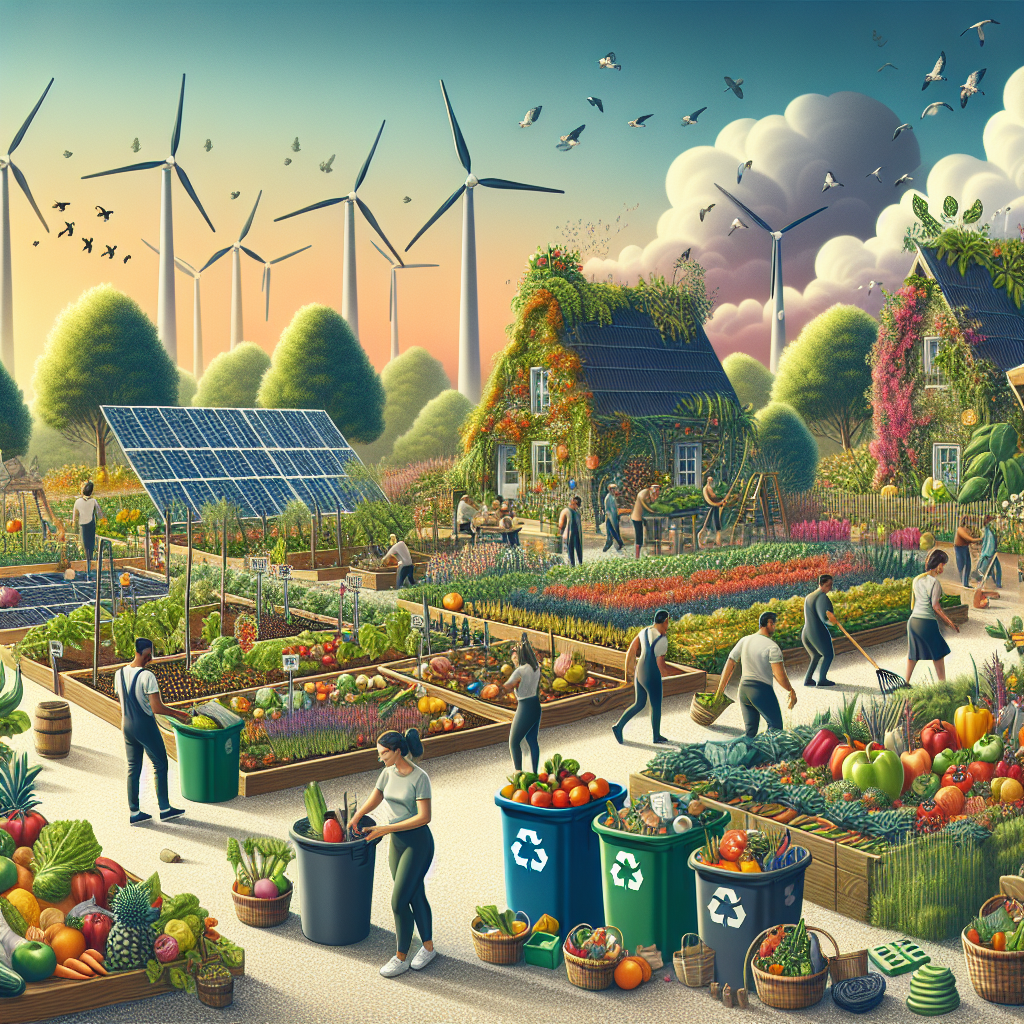Are you interested in adopting sustainable practices in your daily routine but unsure where to start? Look no further! This article is here to guide you on how to seamlessly integrate sustainable habits into your everyday life. From choosing eco-friendly products to reducing waste and conserving energy, discover practical tips that will not only benefit the environment but enhance your overall well-being. Embrace the power of small changes that can make a big difference and embark on your journey towards a more sustainable lifestyle today.
Transportation
Reduce Car Use
One of the most effective ways to reduce your carbon footprint is to reduce your car use. Cars contribute significantly to air pollution and greenhouse gas emissions. So, instead of always relying on your car, consider alternative means of transportation for shorter trips. Take a walk or ride a bike if your destination is within a reasonable distance. Not only will this help reduce your carbon emissions, but it will also improve your personal health and fitness.
Use Public Transportation
Using public transportation is another great way to minimize your impact on the environment. By taking the bus, train, or subway, you can significantly reduce the number of cars on the road and the resulting air pollution. Public transportation is not only eco-friendly but also cost-effective, as it eliminates the expenses associated with owning and maintaining a car. So, next time you’re planning a trip, check out the public transportation options available in your area and consider giving it a try.
Carpool or Share Rides
If public transportation is not a convenient option for you, consider carpooling or ridesharing. Carpooling involves sharing a car with others who are traveling in the same direction or going to the same destination. By sharing rides with friends, colleagues, or neighbors, you can reduce the number of cars on the road and decrease your carbon footprint. Additionally, this can be a great way to turn your commute or long drives into a social experience, building connections and reducing the overall cost of transportation.
Walk or Bike
Walking or biking is not only an excellent form of exercise but also a sustainable transportation choice. If your destination is nearby, consider walking or biking instead of using a car. Not only will you be reducing your carbon emissions, but you’ll also be helping to alleviate traffic congestion in your area. Invest in a good pair of walking shoes or a bicycle, and enjoy the benefits of a healthier lifestyle while minimizing your impact on the environment.
Energy Consumption
Switch to Renewable Energy Sources
Choosing renewable energy sources, such as solar or wind power, is a significant step towards reducing your carbon footprint. Consider installing solar panels on your property to generate clean and sustainable energy for your household. While the initial investment may seem costly, it can pay off in the long run by reducing your energy bills and decreasing your reliance on fossil fuels.
Reduce Electricity Usage
Making conscious efforts to reduce your electricity usage can have a significant impact on the environment. Simple actions such as turning off lights when not in use, unplugging electronics, and using natural light during the day can lead to a considerable reduction in energy consumption. Additionally, replacing traditional incandescent light bulbs with energy-efficient alternatives, such as LED bulbs, can further decrease your electricity usage and save you money over time.
Unplug Electronics When Not in Use
Even when not in use, many electronics continue to draw power from the socket. This phenomenon, known as “vampire power” or “standby power,” contributes to unnecessary energy consumption. To combat this, make it a habit to unplug electronics when not in use or use power strips with surge protectors that can be easily switched off. By doing so, you’ll be taking an active role in reducing your energy consumption and saving money on your electricity bill.
Use Energy-Efficient Appliances
Replacing old and inefficient appliances with energy-efficient models can significantly reduce your energy consumption. Look for appliances that have an Energy Star rating, as these products meet strict energy efficiency criteria set by the U.S. Environmental Protection Agency (EPA). From refrigerators to washing machines, energy-efficient appliances not only save energy but also reduce your carbon footprint and lower your utility bills in the long run.
Water Conservation
Fix Leaks
Leaky faucets, pipes, and toilets can waste a significant amount of water over time. Be proactive and fix any leaks as soon as you notice them. Whether it’s a dripping faucet or a running toilet, these small repairs can make a big difference in terms of water conservation. Not only will you be reducing water waste, but you’ll also be saving money on your water bill.
Collect and Reuse Rainwater
Harvesting rainwater is an excellent way to reduce your reliance on freshwater sources. Consider installing a rain barrel or a rainwater collection system in your yard to capture rainwater for tasks such as watering your plants or cleaning outdoor areas. This practice not only conserves water but also helps prevent runoff and erosion.
Take Shorter Showers
While long, hot showers may be a relaxing indulgence, they also contribute to water waste. By shortening your showers and using a low-flow showerhead, you can conserve a significant amount of water. Aim to keep your showers under five minutes to make the most efficient use of this precious resource.
Use Water-Saving Devices
Installing water-saving devices in your home can make a substantial difference in water conservation. For instance, low-flow faucets and toilets use less water without compromising performance. Dual-flush toilets allow you to choose between a lower water volume for liquid waste and a higher volume for solid waste. By incorporating these devices into your home, you’ll be making a conscious effort to reduce water consumption and protect this valuable resource.
Waste Management
Practice Recycling
Recycling is a fundamental aspect of waste management and an essential step towards reducing your environmental impact. Set up a recycling system in your home and make it a habit to separate recyclable materials from regular waste. Familiarize yourself with your local recycling guidelines to ensure that you’re recycling properly. By doing so, you’ll be conserving resources, reducing landfill waste, and contributing to the circular economy.
Compost Organic Waste
Instead of throwing away organic waste, such as fruit and vegetable scraps, start composting. Composting is an environmentally-friendly process that transforms organic materials into nutrient-rich soil. You can compost in your backyard using a compost bin or opt for indoor composting with a vermicomposting system that uses worms to break down food waste. By composting, you’ll be diverting waste from landfills and creating valuable fertilizer for your garden.
Reduce Single-Use Items
Single-use items, such as disposable plastic utensils, plates, and cups, contribute to significant waste generation. Minimize your use of these items by opting for reusable alternatives. Invest in a set of durable, eco-friendly utensils, plates, and cups that can be washed and reused. By reducing your reliance on single-use items, you’ll be making a positive impact on the environment and reducing the demand for disposable products.
Donate or Reuse Items
Instead of throwing away items that are still in good condition, consider donating or reusing them. Clothing, furniture, electronics, and household items can find new life when donated to charities or shared through online platforms. Not only will you be reducing waste, but you’ll also be contributing to a more sustainable and circular economy. Additionally, repurposing items or getting creative with DIY projects can give old objects a new purpose and extend their lifespan.
Food Choices
Eat Locally and Seasonally
Opting for locally produced and seasonal food is not only beneficial for your health but also for the environment. Locally sourced food requires fewer transportation miles, reducing carbon emissions associated with long-haul transportation. Seasonal produce is often fresher, tastier, and more nutritious. Visit farmers’ markets, participate in community-supported agriculture (CSA) programs, or grow your own food to enjoy the benefits of eating locally and seasonally.
Reduce Meat Consumption
The meat industry is a significant contributor to greenhouse gas emissions and deforestation. By reducing your meat consumption and incorporating more plant-based foods into your diet, you can make a positive impact on the environment and your health. Try adopting a “meatless Monday” or explore vegetarian and vegan recipes for a healthier and more sustainable diet.
Minimize Food Waste
Food waste is a prevalent issue with severe environmental consequences. To minimize food waste in your household, plan your meals in advance, make a shopping list, and buy only what you need. Properly store perishable items and utilize leftovers creatively in other meals. By taking these steps, you’ll be saving money, preserving resources, and reducing the demand for food production.
Support Sustainable Agriculture
Supporting sustainable agriculture practices is crucial for ensuring a healthier and more sustainable food system. Look for labels such as “organic,” “fair trade,” or “Rainforest Alliance Certified” when shopping for food items. These labels indicate that the products have been produced using environmentally-friendly and socially responsible practices. By consciously choosing sustainable options, you’re supporting farmers and producers committed to minimizing their environmental impact.
Shopping Habits
Choose Eco-Friendly Products
When shopping, opt for eco-friendly products that are produced using sustainable materials and processes. Look for products made from recycled materials, renewable resources, or biodegradable materials. Avoid products that contain harmful chemicals or contribute to pollution. By making conscious choices, you’re encouraging businesses to prioritize sustainability and driving positive change in the market.
Buy in Bulk to Reduce Packaging
Buying in bulk is an effective way to minimize packaging waste. Instead of purchasing individually packaged items, consider buying larger quantities and using reusable containers to store them. This approach not only reduces waste but can also lead to cost savings in the long run. Look for stores that offer bulk options for pantry staples, personal care products, and household items.
Shop Second-Hand
Embrace the concept of “reduce, reuse, recycle” by shopping second-hand. Thrift stores, consignment shops, and online marketplaces offer a wide variety of gently used items at affordable prices. Buying second-hand not only reduces waste but also supports a circular economy by extending the lifespan of products. From clothing and furniture to electronics and books, there are numerous opportunities to find unique treasures while reducing your environmental impact.
Bring Your Own Bags
Plastic bags are a significant source of pollution, especially when they end up in waterways or landfills. Make it a habit to bring your own reusable bags whenever you go shopping. Keep a stash of reusable shopping bags in your car or by your front door, and remember to bring them with you whenever you head out. By doing so, you’ll be reducing plastic waste and encouraging others to follow suit.

Home Energy Efficiency
Insulate Your Home
Proper insulation is key to ensuring energy efficiency in your home. Insulated walls, roofs, and windows help maintain a comfortable indoor temperature while reducing the need for excessive heating or cooling. Consider installing insulation or weatherstripping if your home lacks proper insulation. By doing so, you’ll minimize temperature fluctuations, reduce energy consumption, and lower your utility bills.
Use Energy-Efficient Lighting
Switching to energy-efficient lighting options, such as LED bulbs, is a simple but effective way to reduce your energy consumption. LED bulbs use significantly less energy and last much longer than traditional incandescent bulbs. Replace your old bulbs with energy-efficient alternatives to brighten your home while minimizing your carbon footprint.
Programmable Thermostats
Programmable thermostats allow you to control your home’s heating and cooling systems based on your daily schedule. By setting lower temperatures during periods when you’re away or asleep, you can reduce energy usage without sacrificing comfort. Programmable thermostats provide a convenient way to save energy and reduce your home’s environmental impact.
Seal Drafts and Air Leaks
Drafty windows and doors can lead to excessive energy loss and discomfort. Take the time to inspect your home for air leaks and seal them using weatherstripping or caulk. This simple step can significantly improve your home’s energy efficiency and reduce your reliance on heating and cooling systems. By minimizing drafts, you’ll also create a more comfortable living environment for yourself and your family.
Green Gardening
Plant Native Species
When designing your garden or landscaping, opt for native plant species. Native plants are adapted to the local environment and require less water, fertilizer, and maintenance. They also provide habitat for local wildlife, support biodiversity, and promote ecological balance. Research the native plant species in your area and incorporate them into your garden to create a beautiful and sustainable landscape.
Avoid Chemical Pesticides
Chemical pesticides not only harm pests but also have adverse effects on beneficial insects, soil health, and water quality. Instead of relying on harmful chemicals, explore organic and natural pest control methods. Integrated Pest Management (IPM) techniques involve using biological controls and adopting cultural practices to manage pests effectively. By avoiding chemical pesticides, you’ll be creating a safer and healthier environment for yourself, your plants, and beneficial wildlife.
Compost Yard Waste
Managing yard waste through composting is an eco-friendly way to reduce landfill waste and create nutrient-rich soil for your garden. Grass clippings, leaves, and small branches can be composted at home using a compost bin or pile. If you have larger quantities of yard waste, consider using a local composting facility. By diverting yard waste from landfills, you’ll be contributing to a sustainable waste management system and enriching your garden’s soil.
Save Rainwater for Watering
Collecting rainwater is an excellent way to conserve water and reduce your reliance on freshwater sources. Install a rain barrel or a rainwater collection system in your garden to capture rainwater for watering your plants. This practice saves water, reduces stormwater runoff, and can even help prevent soil erosion. Embrace the natural resource of rainwater and make the most efficient use of it in your garden.

Reduce Plastic Use
Choose Reusable Water Bottles and Bags
Single-use plastic bottles and bags are major contributors to environmental pollution. Opt for reusable water bottles made from materials like stainless steel or glass. These durable alternatives can be refilled countless times, reducing your plastic waste. Similarly, bring your own reusable shopping bags whenever you go to the grocery store or shop for other items. By incorporating these habits, you’ll be making a significant impact on reducing plastic pollution.
Avoid Single-Use Plastics
Single-use plastics, such as plastic cutlery, straws, and food containers, have a severe impact on the environment. Avoid these items whenever possible and opt for reusable alternatives. Carry your own set of reusable cutlery and a stainless steel or glass straw. Invest in reusable food containers or wraps to store food instead of relying on single-use plastic containers. By choosing sustainable alternatives, you’re minimizing your contribution to the plastic waste problem.
Use Glass or Stainless Steel Containers
When storing food or beverages, opt for glass or stainless steel containers instead of plastic options. Glass and stainless steel are durable, non-toxic, and can be reused countless times. They don’t leach harmful chemicals into your food or drinks and are fully recyclable when they’ve reached the end of their lifespan. By making this switch, you’ll be reducing your plastic consumption and promoting a safer and healthier environment.
Say No to Plastic Straws
Plastic straws are one of the most unnecessary single-use plastic items. Refuse plastic straws whenever possible or switch to reusable alternatives like stainless steel or bamboo straws. Many establishments now offer eco-friendly alternatives, or you can bring your own straw in a small carrying case. By saying no to plastic straws, you’re taking a stand against plastic pollution and inspiring others to make more sustainable choices.
Educate and Advocate
Spread Awareness
One of the most powerful ways to make a difference is by spreading awareness about sustainable practices. Share your knowledge and experiences with friends, family, and colleagues, and encourage them to make small changes in their daily lives. Use social media platforms or community events to educate and inform others about the benefits of sustainable living and the importance of environmental conservation.
Support Sustainable Organizations
There are numerous organizations dedicated to promoting sustainability and environmental conservation. Support these organizations by volunteering, making donations, or participating in their campaigns and initiatives. By supporting sustainable organizations, you’re contributing to larger-scale efforts to protect the environment and create a more sustainable future.
Advocate for Policy Changes
Advocating for policy changes is a powerful way to influence sustainability on a larger scale. Stay informed about local, national, and global environmental policies and advocate for measures that prioritize sustainability and environmental conservation. Write to your elected representatives, attend public hearings or town hall meetings, and join forces with like-minded individuals and organizations to advocate for the changes you wish to see.
Inspire Others to Take Action
Lead by example and inspire others to take action in their own lives. When others see the positive impact you’re making through sustainable practices, they may be inspired to make changes themselves. Share your experiences, tips, and successes with others and encourage them to join you on your sustainable journey. Together, we can create a collective movement of individuals working towards a more sustainable and environmentally-conscious future.
In conclusion, implementing sustainable practices in your everyday life is not only beneficial for the environment but also for your own well-being. By reducing car use, switching to renewable energy, conserving water, managing waste, making conscious food and shopping choices, improving home energy efficiency, practicing green gardening, reducing plastic use, and advocating for sustainability, you can make a significant impact in creating a more sustainable world. Start with small steps, and gradually incorporate these practices into your daily routine. Remember, every action counts, and together we can make a positive difference for future generations.








